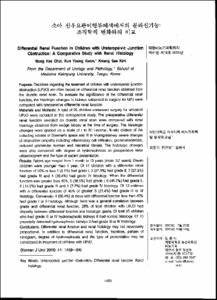소아 신우요관이행부폐색에서의 분리신기능: 조직학적 변화와의 비교
- Alternative Author(s)
- Kim, Kwang Sae; Kwon, Kun Young
- Journal Title
- 대한비뇨기과학회지
- ISSN
- 2005-6737
- Issued Date
- 2000
- Abstract
- Purpose: Decisions regarding the treatment of children with ureteropelvic junction obstruction (UPJO) are often based on differential renal function obtained from the diuretic renal scan. To evaluate the significance of the differential renal function, the histologic changes in kidneys subjected to surgery for UPJ were compared with preoperative differential renal function. Materials and Methods: A total of 25 children underwent surgery for unilateral UPJO were included in this retrospective study. The preoperative differential renal function revealed on diuretic renal scan were compared with renal histology obtained from wedge biopsy at the time of surgery. The histologic changes were graded on a scale of I to IV: I-normal, II-mild dilation of the collecting tubules or Bowman`s space and III to IV-progressively severe changes of obstructive uropathy including inflammatory cell infiltration, glomerulosclerosis, reduced glomerular number and interstitial fibrosis. The histologic changes were also compared with degree of hydronephrosis on preoperative renal ultrasonogram and the type of patient presentation. Results: Patient age ranged from 1 month to 13 years (mean 3.7 years). Eleven children were younger than 1 year. Of 11 children with a differential renal function of 40% or less 1 (9.1%) had grade I, 3 (27.3%) had grade II, 3 (27.3%) had grade III and 4 (36.4%) had grade IV histology. When the differential function was greater than 40%, 5 (38.5%) had grade I, 6 (46.2%) had grade II, 2 (14.3%) had grade III and 1 (7.7%) had grade IV histology. Of 13 children with a differential function of 40% or greater 3 (21.4%) had grade III or IV histology. Conversely, 4 (36.4%) of those with differential function less than 40% had grade I or II histology. Although there was a general correlation between grade and differential renal function, 28% of total children with UPJO had disparity between differential function and histologic grade. Of total 25 children who had grade III or IV hydronephrotic kidneys 6 had normal histology. Of 10 prenatally detected hydronephrotic kidneys 3 had grade III or IV histology. Conclusions: Differential renal function and renal histology may not necessarily proportional. In addition to differential renal function, therefore, pattern of renogram, degree of hydronephrosis and the type of presentation may be considered in treatment of children with UPJO.
Key word : Ureteropelvic junction obstruction, Differential renal function, Renal histology
- Alternative Title
- Differential Renal Function in Children with Ureteropelvic Junction Obstruction: A Comparative Study with Renal Histology
- Publisher
- School of Medicine
- Citation
- 최봉기 et al. (2000). 소아 신우요관이행부폐색에서의 분리신기능: 조직학적 변화와의 비교. 대한비뇨기과학회지, 41(12), 1459–1464.
- Type
- Article
- ISSN
- 2005-6737
- Appears in Collections:
- 1. School of Medicine (의과대학) > Dept. of Pathology (병리학)
1. School of Medicine (의과대학) > Dept. of Urology (비뇨의학)
- 파일 목록
-
-
Download
 oak-bbb-1339.pdf
기타 데이터 / 2.05 MB / Adobe PDF
oak-bbb-1339.pdf
기타 데이터 / 2.05 MB / Adobe PDF
-
Items in Repository are protected by copyright, with all rights reserved, unless otherwise indicated.